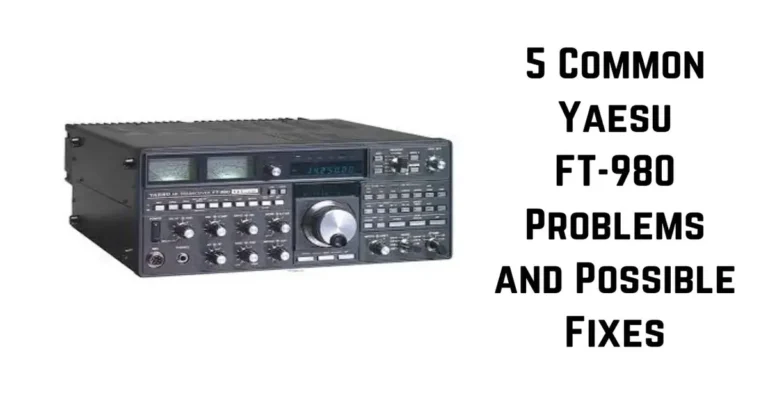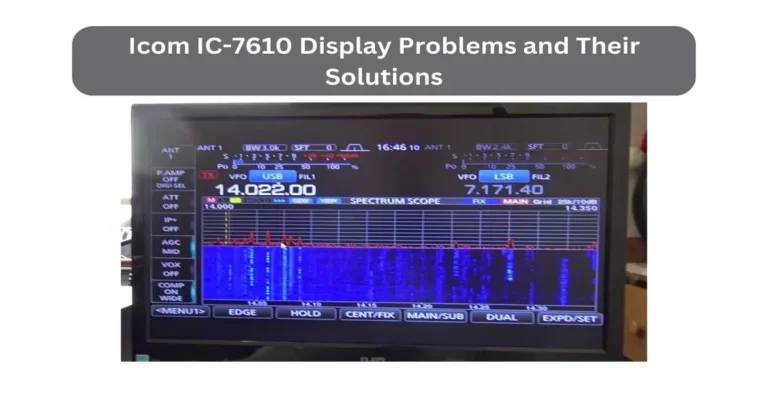5 Common Yaesu FT-840 Problems and Possible Fixes
The Yaesu FT-840 is a popular HF transceiver known for its simplicity and solid performance. Designed for both beginners and experienced ham radio operators, the FT-840 offers a range of features that make it a reliable companion for amateur radio enthusiasts. However, like any piece of electronic equipment, the FT-840 is not without its issues. Over time, users may encounter problems that can disrupt their operations and cause frustration.
In this post, we will explore five common issues faced by Yaesu FT-840 owners and provide possible fixes to help you get your rig back in working order. Whether you’re dealing with power supply issues, receiver sensitivity loss, frequency drift, a faulty display, or audio distortion, understanding these problems and their solutions can save you time and effort. Let’s dive into these common issues and see how they can be effectively addressed.
1. Power Supply Issues
One of the most common problems reported by Yaesu FT-840 users is related to power supply. These issues can manifest in various ways, including unexpected shutdowns, difficulty powering on the rig, or intermittent power loss during operation. Given the critical role of a stable power supply in the operation of the FT-840, these problems can be particularly troublesome.
Possible Causes
Power supply issues are often caused by aging capacitors within the rig, which can lose their ability to store charge effectively over time. Loose connections, either within the power supply unit or in the power cord itself, can also lead to power interruptions. In some cases, the power cord may become frayed or damaged, leading to poor connectivity.
Solutions
To address power supply issues, start by inspecting the capacitors within the FT-840. If you notice any bulging, leakage, or other signs of wear, it may be time to replace them. Ensuring all power connections are secure is another important step. Check the power cord for any signs of damage and replace it if necessary.
Regular maintenance is key to preventing power supply issues. Make it a habit to check the power supply connections and components periodically. Using a reliable, stable power source can also reduce the likelihood of encountering these issues in the future.
Read More: 6 Common Yaesu SM-5000 Problems and Possible Fixes
2. Receiver Sensitivity Loss
Another issue that FT-840 users may encounter is a reduction in receiver sensitivity. This problem can result in poor signal reception, making it difficult to pick up weak signals and reducing the overall effectiveness of the transceiver.
Possible Causes
Receiver sensitivity loss can be caused by a variety of factors, including aging components such as transistors or capacitors within the receiver circuit. Misalignment in the receiver circuit can also lead to reduced sensitivity, as the components may no longer be optimally tuned to capture signals effectively.
Solutions
To fix receiver sensitivity loss, start by checking the alignment of the receiver circuit. If misalignment is detected, perform a realignment to ensure the circuit is properly tuned. Replacing aging components such as transistors, capacitors, or resistors may also help restore sensitivity. If you’re not experienced in handling these components, it may be wise to consult a professional technician.
Regular tuning and calibration checks can help prevent receiver sensitivity loss. Keeping the components within the receiver circuit in good condition will ensure that your FT-840 continues to receive signals clearly.
Read More: 5 Common Yaesu FT-100D Problems and Possible Fixes
3. Frequency Drift
Frequency drift is a common issue that can significantly impact the performance of the Yaesu FT-840. When frequency drift occurs, it becomes challenging to stay on a specific frequency, leading to disruptions in communication.
Possible Causes
Temperature changes are one of the primary causes of frequency drift in the FT-840. Internal oscillators within the rig are sensitive to temperature fluctuations, which can cause them to drift from their set frequency. Over time, this drift can become more pronounced.
Solutions
Installing a temperature-compensated crystal oscillator (TCXO) is an effective solution to minimize frequency drift. The TCXO is designed to maintain stable frequency output even when the temperature varies. Additionally, keeping your rig in an environment with stable temperatures can help reduce the occurrence of frequency drift.
Regularly monitor and calibrate the oscillator within your FT-840 to ensure it remains stable. Avoid placing the rig in areas where it is exposed to significant temperature changes.
Read More: 5 Common Yaesu FT-1000MP Problems and Possible Fixes
4. Faulty Display
A faulty display is another common problem that can arise with the Yaesu FT-840. The display may become dim, flicker, or fail entirely, making it difficult to read frequency or mode information.
Possible Causes
Faulty displays can be caused by aging LEDs, which may lose brightness over time. Connection issues within the rig or problems with the power supply can also lead to display failures.
Solutions
To fix a faulty display, consider replacing the LEDs if they have become dim. Check all connections related to the display and secure any loose ones. Investigating the power supply for issues that could be affecting the display is also important; resolving these can often restore the display to proper working condition.
To prolong the life of the display, operate your FT-840 within the recommended conditions. Avoid exposing the rig to excessive heat or moisture, as these can accelerate the deterioration of the display components.
Read More: Most Common Yaesu FTDX-1200 Problems and Possible Fixes
5. Audio Distortion
Audio distortion is a frustrating issue that can affect both the transmission and reception of signals on the Yaesu FT-840. Distorted audio can make communication unclear and challenging.
Possible Causes
Audio distortion is often caused by faulty audio integrated circuits (ICs) within the rig. Dirty connectors or problems with the internal or external speaker can also lead to distorted audio output.
Solutions
Begin by cleaning the connectors to ensure a clean connection. If the issue persists, check the speaker for any damage or wear. Replacing faulty audio ICs is another potential solution to restore clear audio. Testing the rig with an external speaker can help determine if the problem lies with the internal speaker.
Maintaining clean and secure connections will help prevent audio distortion. Regularly inspect the audio components within your FT-840 to catch any issues early.
Read More: 6 Common Yaesu DR-1X Problems and Possible Fixes
Conclusion
In summary, while the Yaesu FT-840 is a dependable and popular HF transceiver, it is not immune to certain common issues. By understanding and addressing power supply issues, receiver sensitivity loss, frequency drift, faulty displays, and audio distortion, you can keep your FT-840 operating at its best. Regular maintenance, including checking connections, calibrating circuits, and replacing aging components, will help prevent these problems from arising.
If you do encounter any of these issues, following the suggested fixes can save you time and ensure your rig continues to perform reliably. If problems persist, consider consulting a professional technician to avoid further complications. Share your experiences or additional tips in the comments below, and keep enjoying your ham radio adventures!






